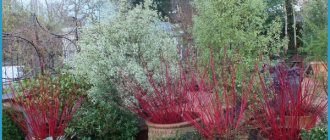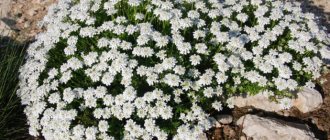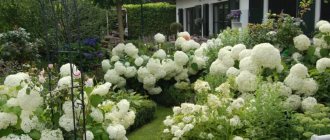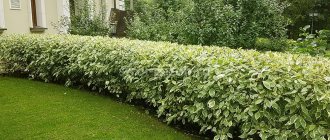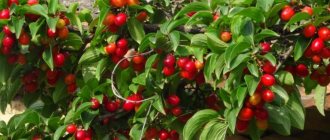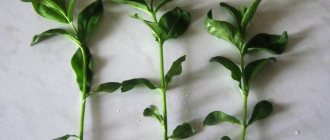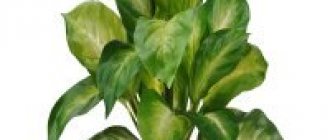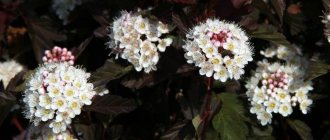Short description
Derain Elegantissima is a deciduous shrub belonging to the Dogwood family. It got its name for the elegant appearance of the crown and the variegated color of the foliage. This decorative form is most often used in landscape design of plots, gardens, and urban landscaping, as it looks advantageous in any composition.
Derain Elegantissima is a deciduous shrub of the Dogwood family.
The plant has very thin and flexible shoots, intensively branching and stretching upward. Without regular pruning, it can reach a height of 3 m, growing 4–5 m wide. The color of the shoots is brown, becoming rich red closer to autumn, thanks to which the bush continues to decorate the garden even in winter. A special feature of the variety are large heart-shaped leaves of a grayish-green color with white or cream strokes and an openwork edging along the edge.
The first flowering of the shrub occurs at the age of three. Subsequently, it blooms twice a year - in early summer and in September, forming dense inflorescences consisting of many small white flowers. After flowering, fruits are formed on the shoots - round berries with a diameter of about 8 mm. They ripen just in time for September, when the bush blooms again, which gives it additional decorativeness.
The fruits of the plant - small yellowish-white drupes - are inedible and are not used for food.
Botanical characteristics of the plant
White dogwood Elegantissima (full name in Latin Cornus alba Elegantissima) belongs to the group of deciduous shrubs of the Dogwood family. Thanks to its high frost resistance, as noted in the description of the variety, the ornamental shrub can withstand harsh Russian winters. In the natural environment it is found mainly in Siberia and the Far East.
White dogwood Elegantissima is a deciduous shrub of the Dogwood family.
White dogwood Elegantissima is considered one of the brightest and most spectacular representatives of the Dogwood family. The average height of the bush is 3 m. The size of the crown depends on the chosen molding option, so the diameter of the bush can vary from 3 to 5 m. Most often, the plant is given a spherical or hemispherical shape.
Young shoots, which are characterized by an olive-green color, are highly flexible. The bark of mature shoots is grayish-red in color, which is why the plant is popularly nicknamed redwood. Spreading branches tend to intertwine abundantly.
Derain Elegantissima attracts attention with the unusual color of its leaves. The heart-shaped and wide-oval leaf blades are painted bluish-green with a delicate white-cream edge. The surface of the leaf is slightly concave, length – up to 10 cm.
Blooms in May-June. Sometimes repeated flowering is possible, which occurs in the second ten days of August. The variety is characterized by corymbose-type inflorescences with small flowers of white or light pink color. At the end of the flowering period, small blue-gray fruits are formed. Derain Elegantissima berries are not suitable for human consumption.

Elegantissima has an unusual leaf color
Rules for planting ornamental shrubs
With proper planting, a shrub can grow in one place for up to 50 years, but for this you need to take into account the following requirements.
Optimal timing
It is recommended to plant young bushes with an already formed root system in the fall, 1.5–2 months before the onset of constant cold weather. During this time, the plant will have time to take root and adapt to new conditions. Seedlings in pots can be transplanted into the ground in the spring, but in this case they must be lowered into the hole along with a ball of earth, which will protect the roots from damage and speed up the rooting process.
Requirements for location and soil
All types of derain take root well on any soil except clay and sandy loam. Loose fertile soil fertilized with organic matter is ideal. Planting on poor soils is also possible, but regular fertilizing will be required. A significant advantage of the variety is its immunity to groundwater, but this should not be abused. If to create a composition the bush has to be placed in the wrong place, you should take care of drainage in advance.
For better development, it is recommended to plant the shrub in open, illuminated areas or in light partial shade.
Author's advice
Slight shading for this variety is even desirable, since under direct rays its foliage can become too faded. In the shade, on the contrary, the white edging on the leaf plates will become narrow and unnoticeable, which is why the plant will lose its decorative effect.
Ornamental shrub loves full sun and light partial shade.
Seedling planting algorithm
The hole for planting is dug in 2 weeks. It should be approximately 1.5 times wider than the seedling's earthen ball. Humus or compost, as well as mineral fertilizers, are placed at the bottom. This composition will provide the plant with the necessary nutrients for the next few years. To compact the soil, water is poured into the hole.
The landing algorithm is as follows:
- The seedling is watered and after 10–15 minutes removed from the pot along with a lump of earth. Plants with bare roots are immersed in water for a couple of hours before planting.
- Carefully, supporting from below, the seedling is transferred to the planting hole and placed in the center so that after planting the root collar is not below the soil surface.
- Next, the bush is covered with earth, compacting it periodically.
- Seal the tree trunk circle and water it abundantly.
When planting in the fall, you don’t need to do anything else. If this happens in the spring, then the tree trunk area is mulched so that the soil does not dry out, and the seedling is shaded from the sun for the first 3–4 days.
Features and secrets of growing white dogwood
White derain shrubs are unpretentious and do not require any special care. To maintain the decorative appearance of plants, it is enough to carry out only a few activities.
Watering and fertilizing
Only recently planted shrubs need regular watering. Adult bushes need enough moisture from precipitation and melting snow, but in abnormally hot weather they also need to be watered at the rate of 2 buckets per plant. Watering is done in the evening or early in the morning, which helps protect the leaves from burns.
The first fertilizing is applied after 3 years. Until this time, the plant consumes the fertilizers added during planting. The bushes are fed infrequently, about once every 2-3 years, and then only in case of illness or weakness. You can fertilize with both mineral mixtures and humus, humus or compost. You don’t need a lot of organic matter - just add 100 g to each bush.
Pruning and crown formation
Over the course of a year, the bush grows by about 50–60 cm, so it needs to be pruned and trimmed several times a season. This can be done at any time, except for the period when the juices are actively moving. The first pruning of the bush is carried out 3 years after planting. It involves removing all damaged branches, as well as removing ⅓ of the crown for the purpose of its further formation.
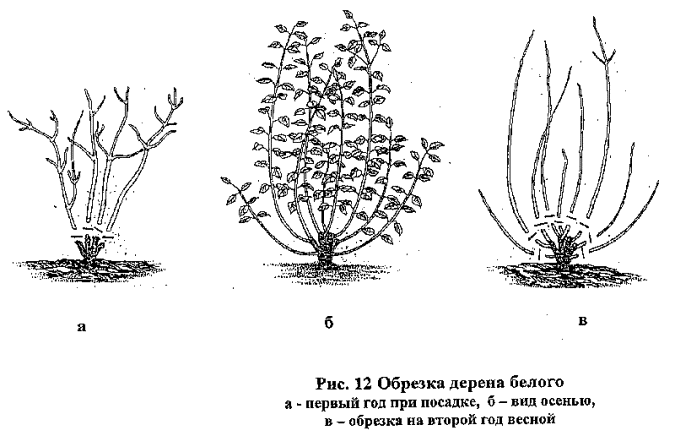
White tree trimming schemes
The pattern of subsequent pruning depends on what shape the shrub needs to be given. Usually, shoots that are broken and protruding to the sides are regularly trimmed. The bush is pruned more thoroughly in the fall, thinning it and removing 3-4 leading shoots. This procedure promotes abundant flowering.
Once every 3–4 years, all shoots are cut to a height of 15–20 cm in order to rejuvenate the bush.
Preparing for winter
Despite the fact that the roots of white dera are superficial, it is included in the list of the most winter-hardy plants. Even in the northern regions, shrubs can winter without shelter, as they can easily withstand severe frosts, and if they freeze, they quickly recover. The only exceptions are young seedlings planted in the fall. In harsh climates, it is better to cover them during the first winter.
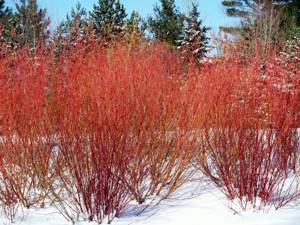
Winter-hardy culture does not require additional shelter for the winter
Reproduction of the white Elegantissima tree
The ornamental shrub reproduces well in three ways.
Seeds
Propagation by seeds is a long process. For sowing, fresh material collected in the fall is used. The seeds are stratified - kept in the cold for a couple of months, after which they are planted in the substrate to a depth of 3-5 cm. Sowing is done in a greenhouse in the spring, but you can also sow directly into the ground before winter, then stratification is not needed - nature will do everything itself. Seeds take a very long time to germinate, 2–3 years, and it takes up to 8 years to grow an adult bush.
By layering
The plant reproduces best by root layering. To do this in the summer, you need to bend the lowest young shoot to the ground, fix it, sprinkle it with earth and water it from time to time. By autumn, a root system will have formed on this cutting, after which it can be separated with pruning shears and transplanted to a new location.
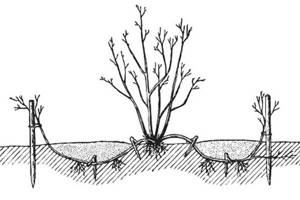
Reproduction of ornamental shrubs by layering
Cuttings
The material is harvested at the beginning of summer from slightly woody but still flexible shoots, or those left over from spring pruning. The cuttings are planted in a moistened substrate at an angle of 45°, the container is transferred to a greenhouse, where high humidity and air temperature are maintained at 25–30 °C. By autumn, the cuttings have formed roots, after which they are transplanted into pots and kept in the basement until spring planting.
Reproduction
White dogwood has lived for more than 50 years. Planting and caring for it does not require much effort. Therefore, it is worth growing it in the garden.
The plant propagates by seeds, cuttings and layering.
- Seeds are collected in the fall. It should be noted that they have excellent germination. You can sow them in the fall, but it is better to first stratify them in the cellar or in the refrigerator at a temperature of about +4 degrees. It should be noted that where deer bushes grow, the seeds can be carried by birds, so they can sprout in the most unexpected places.
- Green cuttings do not take root very well. Those that have begun to grow may freeze out in the first winter. It is better to root a two-year-old woody cutting, since root buds are present along the entire length of the branch.
- Reproduction by layering is the best way. It is enough to dig them in the spring to a depth of 10 cm and constantly water the soil. Roots will appear in about six months. In the fall or next year, the young bush should be planted in a permanent place, but it is better to leave it for another year and replant the fully formed bush.
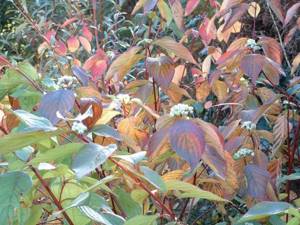
Use in landscape design
Due to their flexibility and ability to tolerate pruning, white deer shrubs are very widely used in the design of personal plots:
- they make beautiful “living” arches and dense hedges of different heights, which can be used to divide the space into zones or hide an unsightly building;
- with the help of a haircut, they are easily transformed into decorative garden elements: a ball, a cube, a hemisphere and other shapes;
- in a group composition they stand out in contrast due to light foliage;
- several trimmed plants look harmonious at the front of the house;
- low plants can be used to frame garden paths;
- a group composition of several shrubs planted in the form of an island looks elegant;
- the bush can be planted in the middle of the lawn, where it will create a bright contrast with the emerald grass.
The variegated shrub looks best in a composition and against a background with openwork ornamental plants, such as conifers.
In short, the Elegantissima variety is a universal crop that can decorate any area, both in summer and winter. Despite its elegant and rather fragile appearance, this is a very hardy plant that can grow and decorate the garden in almost any region.
Derain elegantissima to help park designers
- Because of its remarkable color, the plant looks exquisite next to other crops. Green leaves framed with white edges will create a lacy outfit along the side of the garden alley. White Elegantissima turf is planted in front of the trees to highlight them and create a volume effect. The bushes are trimmed and pruned to various shapes, fortunately the turf can withstand this. Used to visually create living barriers of all kinds.
- In autumn, when the leaves fall off, the plant pleases the eye with red trunks of branches. If at the same time the first drifting snow appears, then against the backdrop of a dull autumn or early winter such colors are invariably popular and lift the spirits. With the help of a picturesque image, they hide the walls of unsightly outbuildings and are used to protect highway exhaust from exhaust.

